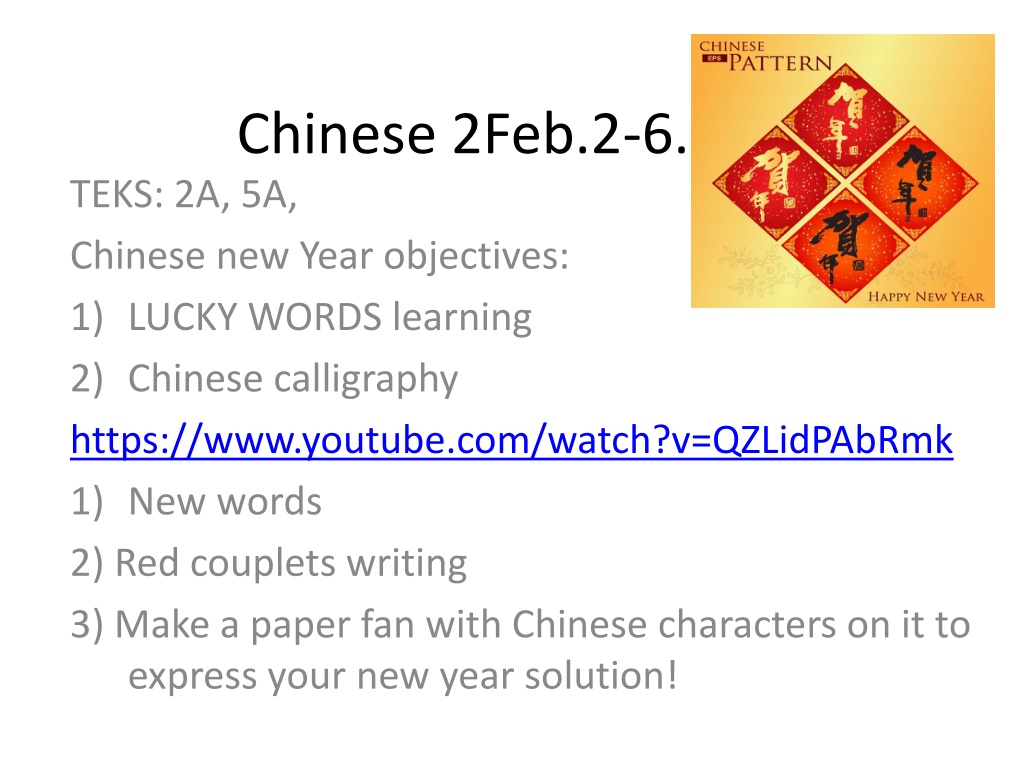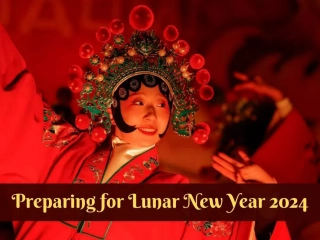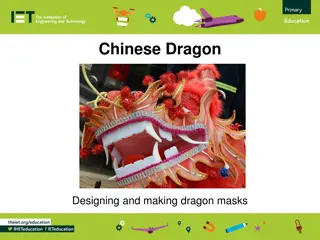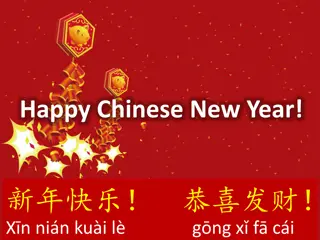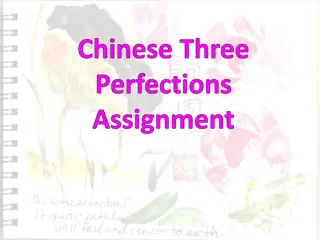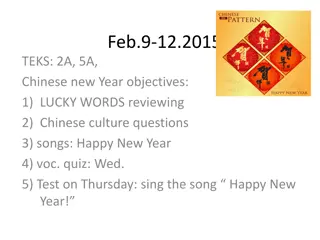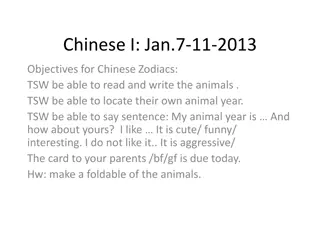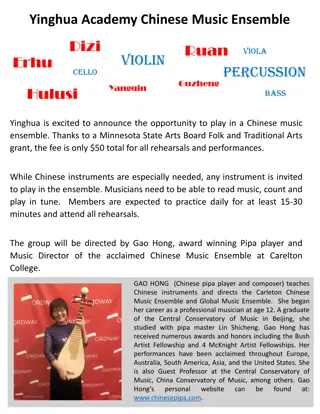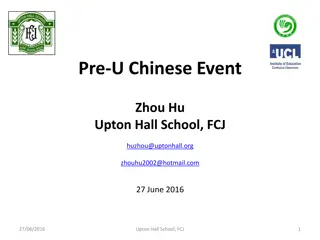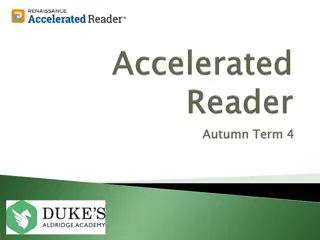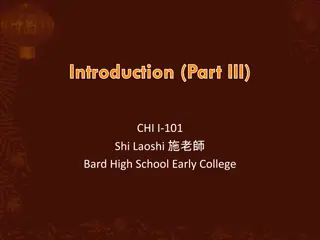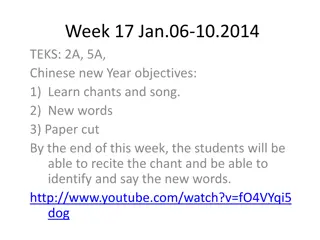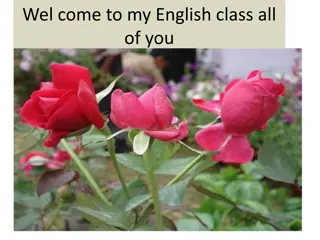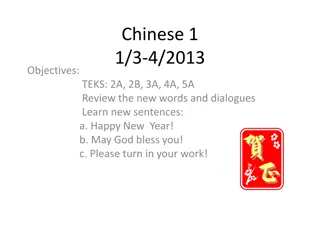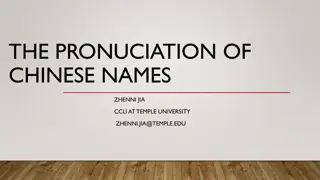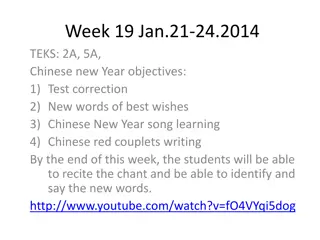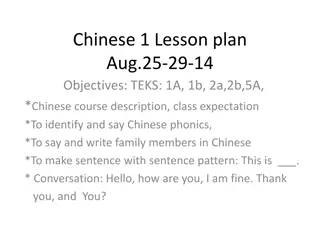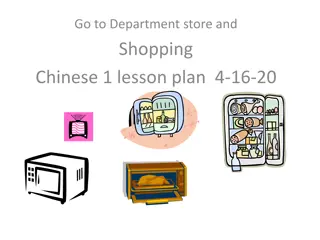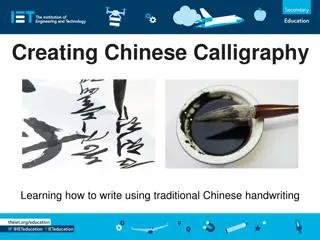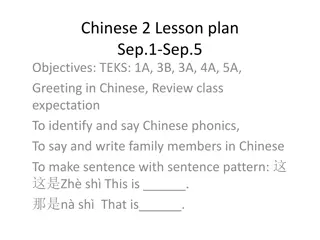Chinese New Year Celebration: Learning Lucky Words and Calligraphy
Explore the rich traditions of Chinese New Year through learning lucky words, practicing calligraphy, and creating festive paper decorations. Immerse yourself in the culture with new vocabulary, red couplets, and paper fan art while celebrating prosperity and blessings for the coming year.
Download Presentation

Please find below an Image/Link to download the presentation.
The content on the website is provided AS IS for your information and personal use only. It may not be sold, licensed, or shared on other websites without obtaining consent from the author. Download presentation by click this link. If you encounter any issues during the download, it is possible that the publisher has removed the file from their server.
E N D
Presentation Transcript
Chinese 2Feb.2-6.2015 TEKS: 2A, 5A, Chinese new Year objectives: 1) LUCKY WORDS learning 2) Chinese calligraphy https://www.youtube.com/watch?v=QZLidPAbRmk 1) New words 2) Red couplets writing 3) Make a paper fan with Chinese characters on it to express your new year solution!
Monday obejctives Teks: 1a, 1b, 5a New words about the lucky phrases History of Chinese New Year celebration Students will be able to read the lucky phrases with the help of pinyin. Hw: make a quizlet/ flash card to practice new words at home.
1. Xnnin kuil! Happy new year! 2. G ngx f c i! Happiness and prosperity 3. C iyu n gu ng j n May Wealth pour in from different directions 4. sh ngy x ngl ng Prosperous business 5. Qi nch ng s j n Have a bright future 6. b b g o sh ng Get promoted! 7. h ji x ngf Joyful family life 8. Y ngch n ji f Embrace Spring and Receive the good luck!
Tuesday objectives TEKS: 1A, 1B,5A New words of lucky words Lucky words practice: write red couplets on the paper that you will give as a gift to your friends, teachers.
1. shnt jinkng Good health 2. l ngm j ngsh n Having spirit as dragon and horse 3. ji nk ng ch ngzh ng Grow up healthily 4. xu x j nb make progress in study
1. hjihun l Happy and harmony within the family 2. b it uxi l o grow old together/ lifetime together 3. b ini n h o h love and devote to each other all life 4. y ng ji t ngx n May you share the same mind forever.
fish= abundance abundance of money all through the year.
Grow old together, long and joyful marridge
Ciyun gung jn May Wealth pour in from different directions
(hjihun l Happy and harmony within the family
Wednesday Writing red couplets: send them to family. And put it on both side of doors on Feb.16th2015
Thursday Teks: 1b, 1c Voc. quiz Chinese new Year song Finish rest of the red couplets
Voc.quiz X nni n ku il ! ___________________________ G ngx f c i! _____________________________ C iyu n gu ng j n ______________________________________ sh ngy x ngl ng _______________________________ Qi nch ng s j n _______________________________ b b g o sh ng ________________________________ h ji x ngf ___________________________________ Y ngch n ji f _________________________________ sh nt ji nk ng ________________________________ 1. 2. 3. 4. 5. 6. 7. 8. 9. 10. l ngm j ngsh n ________________________________ 11. ji nk ng ch ngzh ng ____________________________ 12. xu x j nb ____________________________________ 13. h ji hu n l ___________________________________ 14. b it uxi l o ___________________________________ 15. b ini n h o h _________________________________ 16. y ng ji t ngx n ________________________________.
Chinese New Year songs Review Happy New Year song https://www.youtube.com/watch?v=AI9zudQqP 70 Learn https://www.youtube.com/watch?v=sf0btvROw XQ
M i ti o d ji xi o xi ng M i g r n de zu l Ji nmi n d y j hu Ji sh g ngx g ngx G ngx g ngx g ngx n ya G ngx g ngx g ngx n D ngti n y d o j nt u Zh nshi h o de xi ox W nnu n de ch nf ng ji y o Chu x ng d d G ngx g ngx g ngx n ya G ngx g ngx g ngx n
New words G ngx congratulations M i, each ti o, measure word for an item that is long and narrow:river, tie, belt, etc j , measure word for sentence d , adj. big xi o , adj, small ji , noun street xi ng, noun, lane zu , noun, mouth l , inside Ji nmi n , meet in person d y , first hu , talking ji , just y o D ngti n , winter y d o , as soon as j nt u, end Zh n, adv. Really, truly xi ox , n. news W nnu n, adj. warm ch nf ng, n. spring breeze y o , will chu , vt. To blow x ng, vi. wake up d d , n. land
Friday: make paper fan and decorate the classroom Teks: 5a Each of you make a fan with two colors You need to write two good luck phrases on the fan before you fold the paper. Follow the instruction to make the fan. Decorate our classroom. https://www.youtube.com/watch?v=Oy_hJ4IkjHY https://www.youtube.com/watch?v=spVM2C4Uozg https://www.youtube.com/watch?v=xzgo45ili 7Q
Extra information about Chinese New Year Traditions Important days of the 15-day New Year Festival, including: 1)New Year s Eve: 2) visiting temple and visit the seniors of the family on the first day of Chinese New Year. Eat rice dumpling to have sweet and smooth new year. 3) Visiting wife s parents on the second day s of Chinese New Year. 4) JIE CAI CENG: Welcoming the Gods of Wealth and Prosperity On the 5th day of New Year's, it is believed that the gods of prosperity come down from the heavens. Businesses will often participate in setting off firecrackers as they believe it will bring them prosperity and good fortune for their business.
YUAN XIAO JIE: Festival of Lanterns The 15th day of the New Year is known as The Festival of Lanterns and marks the end of the Chinese New Year celebrations. All types of lanterns are lit throughout the streets and often poems and riddles are often written for entertainment. There are also paper lanterns on wheels created in the form of either a rabbit or the animal of the year (Pig for 2007). The rabbit lantern stems from a Chinese myth or fairytale about a female goddess named "Chang E" who jumped onto the moon. So she wouldn't travel alone, she brough a rabbit with her to keep her company. It is said that if your heart is pure enough, you can see the goddess Chang E and her rabbit on the moon on this day.
Red envelopes Called "hong bao" in Mandarin, the red envelopes filled with money are typically only given to children or unmarried adults with no job. If you're single and working and making money, you still have to give the younger ones the hong bao money. The color red denotes good luck/fortune and happiness/abundance in the Chinese Culture and is often worn or used for decoration in other celebrations.
Dragon The Dragon is present in many Chinese cultural celebrations as the Chinese people often think of themselves as descendants of the mythical creature. On the fifth day of the New Year when many people have to start going back to work, they will also have the Dancing Dragons perform in the front of the office building. On the 15th day of the New Year (Yuan Xiao Jie), they will also have a lot of dancing dragon performances. The dragon represents prosperity, good luck and good fortune.
Traditional Foods The Chinese New Year's Eve meal is the most important dinner of the year. Typically, families gather at a designated relative's house for dinner, but these days, many families often celebrate New Year's Eve dinner at a restaurant. Many restaurants require reservations months in advance. There are also some families that hire a professional chef to come cook at their house. Chefs are often busy running from one home to another cooking dinners for different families on New Year's Eve.
How many days is Chinese New Year celebration? Chinese New Year is a 15-day celebration and each day, many families rotate celebrations between homes of their relatives. The fest ivies are day-long and sometimes, a family ends up cooking two meals for their relatives, once at lunch and once at dinner. These dishes used to be all made from scratch, but now people can easily buy them prepackaged at the supermarkets.
Eight Treasures Rice (contains glutinous rice, walnuts, different colored dry fruit, raisins, sweet red bean paste, jujube dates, and almonds).
Tang Yuan" - black sesame rice ball soup; or a Won Ton soup.
"Song Gao", literally translates to "loose cake"- which is made of rice which has been coursely ground and then formed into a small, sweet round cake.
